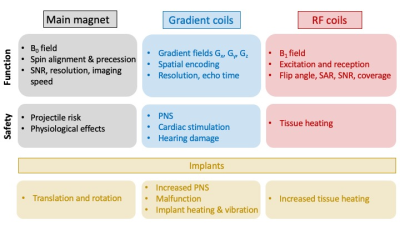Weekday Course
MR Physics for Clinicians: Hardware, Fields & Contrast Agents
ISMRM & SMRT Annual Meeting • 15-20 May 2021

| Concurrent 7 | 14:30 - 15:00 | Moderators: Virginie Callot & Simon Robinson |
 |
MR System Components & Safety Implications
Filiz Yetisir
The magnetic fields produced by the main magnet, gradient coils and RF coils are essential in creating an MR image. They enable spin alignment and precession, spatial encoding, and spin excitation and signal reception respectively. On the other hand, the magnetic and electric fields generated by these MR system components pose certain risks such as projectile effect, nerve stimulation, hearing damage and tissue heating. The underlying physics of the function and the safety implications of the main magnet, gradient coils and RF coils are explained in this talk without mathematical detail. Additionally, increased safety risks due to implants are discussed.
|
|
| High-Field Imaging: From Physics to Clinics
Anja van der Kolk
In this lecture, we will discuss the perks of high field MRI and how they can improve MR images and lesion detection, but also the costs and challenges we should accept and/or try to change. We will then translate these physics issues into practice: what quality and type of MR images can we acquire with high field MRI, and what limitations should we take into consideration? Equipped with this background in basic physics, we will then discuss how we can directly use high field MRI in clinical practice: the clear-cut clinical indications as well as promising avenues outside the brain.
|
||
| Contrast Agents
Alexander Radbruch
|
The International Society for Magnetic Resonance in Medicine is accredited by the Accreditation Council for Continuing Medical Education to provide continuing medical education for physicians.